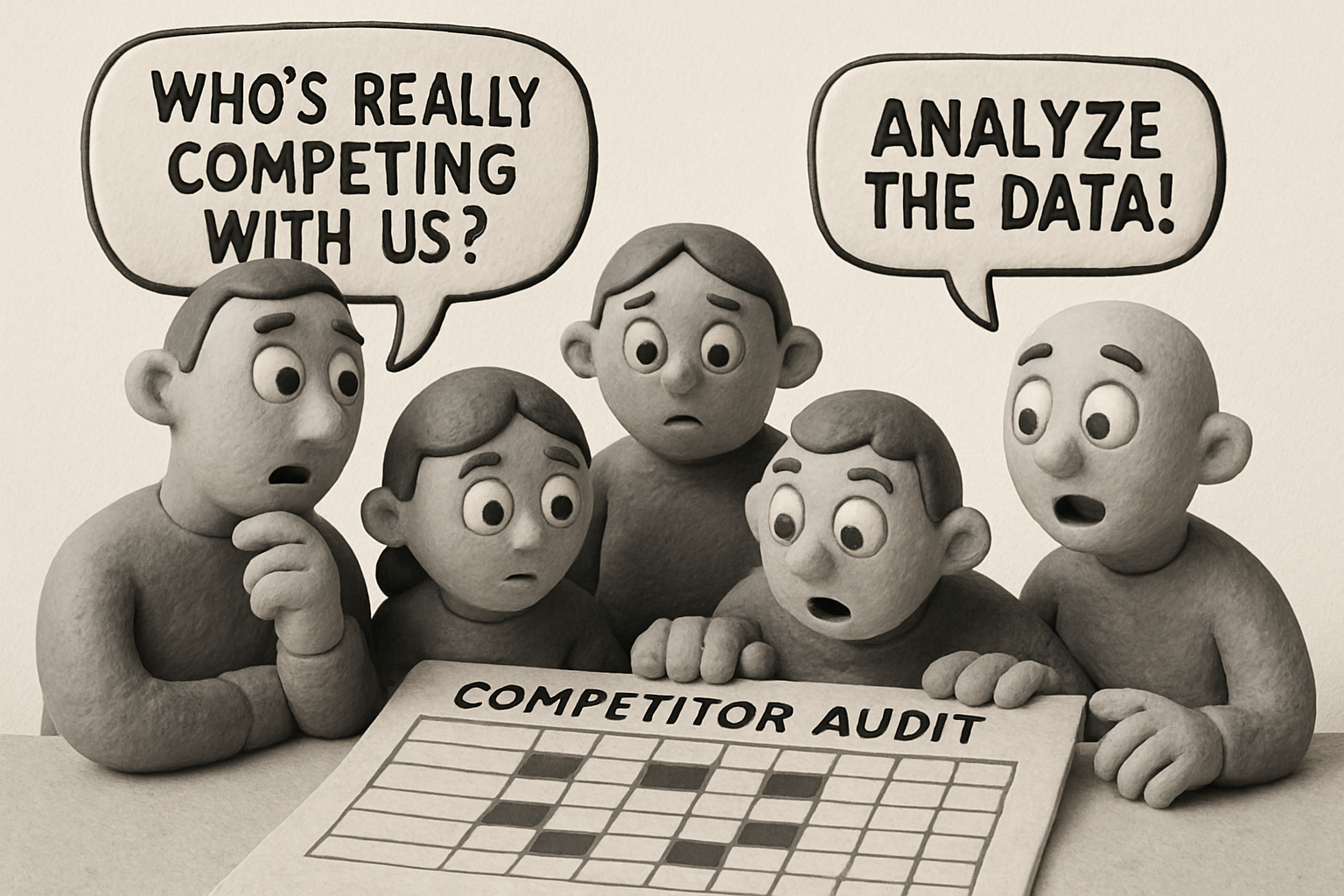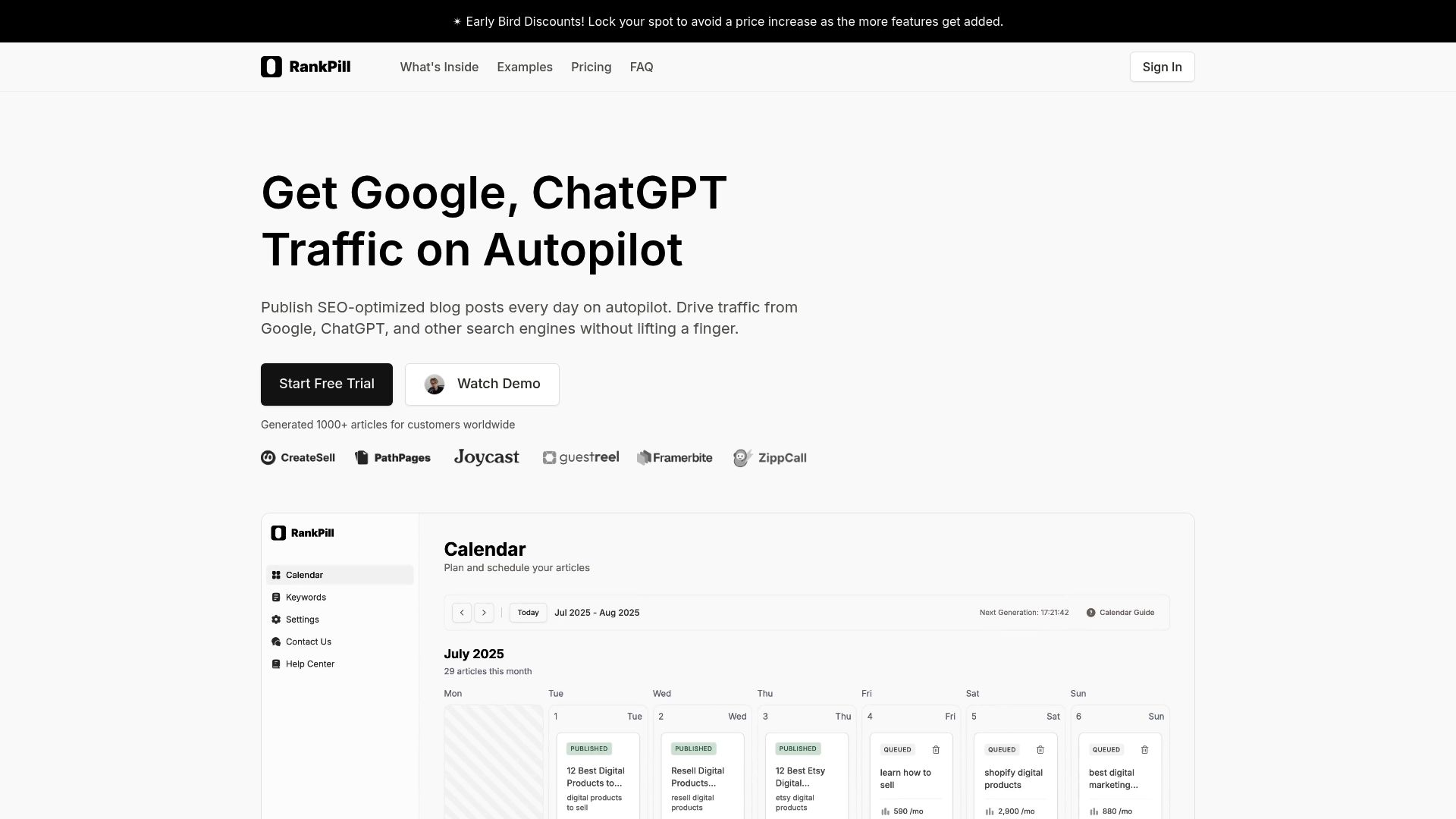In 2025, the battle for organic traffic is at an all-time high—standing out on search engines demands more than great content alone.
If you're not already mastering content competitor analysis, you're giving your rivals a free pass to outrank you. This guide cuts through the noise, showing you how to spot true competitors, audit their strengths and weaknesses, find hidden keyword gaps, and turn insights into a winning strategy.
Ready to outsmart the competition? Follow along for actionable steps and pro-level tactics that will give your SEO results a strategic edge.
Understanding Content Competitor Analysis in 2025
In 2025, the digital content battlefield has become increasingly complex. To win organic traffic, brands must go beyond surface-level monitoring and embrace a smarter, data-driven approach to content competitor analysis.

The Evolving SEO Landscape
Search engines have undergone a seismic shift. Google’s algorithms now rely heavily on AI, transforming how content is ranked and discovered. The explosion of AI-generated content has led to unprecedented content volume, making competition on the SERP tougher than ever.
Recent studies reveal that over 80% of marketers cite content saturation as their top challenge. With AI shaping search experiences, brands must adopt smarter, more nuanced content competitor analysis to stay ahead. As explored in AI's Role in SEO Evolution, adapting your strategy to these shifts is essential for SEO success in 2025.
What is Content Competitor Analysis?
Content competitor analysis is the strategic process of identifying, evaluating, and benchmarking your actual online rivals—not just your business competitors. Unlike traditional competition, your fiercest content competitors may be media outlets, aggregators, or industry blogs that dominate your key SERPs.
For example, a SaaS company might find that niche blogs or review sites outrank direct competitors for valuable keywords. Focusing on content competitor analysis, rather than just business rivals, uncovers who truly captures your audience’s attention in organic search.
| Type | Example | Relevance on SERP |
|---|---|---|
| Business Competitor | SaaS vendor | Sometimes |
| Content Competitor | Industry blog, media | Frequently |
Why Content Competitor Analysis Matters
A robust content competitor analysis uncovers the strengths and weaknesses of your rivals’ content, revealing valuable gaps and opportunities. This process allows you to refine your content strategy, target more effective keywords, and boost your share of organic traffic.
Data shows that brands leveraging competitor analysis see up to a 50% increase in targeted traffic and improved ROI. By understanding what works (and what doesn’t) for others, you can allocate resources smarter and achieve measurable gains over your competition.
Key Challenges in 2025
The landscape for content competitor analysis in 2025 is riddled with complexities. The rise of AI-generated content, rapid shifts in trending topics, and the integration of multimedia formats force marketers to rethink their approach.
Tracking competitors now means monitoring blogs, YouTube channels, and social platforms. Common pitfalls include chasing the wrong competitors, using outdated tools, or conducting only superficial audits. Throughout this guide, you’ll discover solutions to these challenges, ensuring your content competitor analysis remains future-proof and impactful.
Step 1: Identifying Your True Content Competitors
To get ahead in content competitor analysis, you need to identify not just obvious business rivals but the real players competing for your organic visibility. This step forms the bedrock of your strategy, ensuring every action is targeted and data-driven.

Building a Competitor Audit Spreadsheet
Start your content competitor analysis by building a well-structured audit spreadsheet. This tool will help you organize findings and spot patterns across different competitors.
Set up columns such as:
| Company | Channels | Content Volume | Topics | Subtopics | Tone | Frequency | Quality | Technical Aspects |
|---|---|---|---|---|---|---|---|---|
| ExampleCo | Blog, YouTube | 50+ posts | SEO, PPC | Local SEO | Professional | Weekly | High | Fast, HTTPS |
A spreadsheet modeled after Madison Marketing’s template allows you to track everything from content type to technical health. This systematic approach streamlines your content competitor analysis, making it easier to compare, contrast, and prioritize action items.
Using SEO Tools to Discover Competitors
Modern SEO tools are essential for uncovering who you’re really competing with in the SERPs. Platforms like Ahrefs, SEMrush, and SpyFu analyze keyword overlap and domain visibility to surface your true content competitors.
For example, SEMrush’s competitor discovery feature lets you enter your domain and reveals sites sharing similar keyword rankings. Over 70% of marketers now rely on these tools for competitor research, reflecting their critical role in content competitor analysis. For step-by-step keyword-based strategies, check out How to Get Competitor Keywords.
Using these insights, you’ll quickly see which sites are battling for the same audience, even if they aren’t direct business rivals.
Manual Methods for Competitor Discovery
Don’t overlook manual research in your content competitor analysis. Start by Googling your target keywords and noting the domains dominating the first page. Dive into their websites—explore their blogs, resource centers, and knowledge bases.
Pay attention to both local and national competitors. Sometimes, a media outlet or industry aggregator may outrank traditional businesses. Manually reviewing SERPs and content sections helps you spot less obvious competitors and ensures your analysis is comprehensive.
Evaluating Content Relevance and Persona Targeting
It’s not enough to know who’s publishing content—you need to assess if their material targets the same buyer personas as you. Analyze their content angles, messaging, and calls to action.
Does their content speak to decision-makers, practitioners, or another segment? If there’s a misalignment in persona targeting, their threat level in your content competitor analysis may be lower. Use these insights to refine your own content approach and prioritize genuine competitive threats.
Technical and UX Factors in Competitor Identification
Technical SEO and user experience are major factors in content competitor analysis. Assess site speed, HTTPS security, and navigation using tools like Google PageSpeed Insights or Sandbox.
A competitor with poor mobile responsiveness or clunky navigation is less likely to retain visitors, even if they rank well. Consider how UX and technical health impact overall content competitiveness—sometimes, technical weaknesses are opportunities for you to leap ahead.
Step 2: Auditing Competitor Content Effectively
Effective content competitor analysis hinges on a thorough audit of your rivals’ content ecosystem. This step goes beyond surface-level observations—here, you’ll systematically break down what, how, and why competitors are winning (or losing) in your space. Let’s dive into each aspect of a successful audit.

Cataloging Content Types and Volume
Start your content competitor analysis by cataloging the types and volume of content your competitors produce. This involves tracking formats like blog posts, guides, videos, infographics, and webinars. Use a spreadsheet to log what each competitor publishes and how often.
| Competitor | Blog Posts/Month | Guides | Videos | Infographics | Webinars/Quarter |
|---|---|---|---|---|---|
| A | 4 | 2 | 1 | 3 | 1 |
| B | 2 | 1 | 0 | 1 | 0 |
| C | 6 | 3 | 2 | 2 | 1 |
Breaking it down this way helps you spot content gaps and set benchmarks. By visualizing the landscape, your content competitor analysis becomes more actionable and organized.
Analyzing Keyword Targeting and Topic Coverage
Next, examine which keywords and topics your competitors are targeting. Tools like Ahrefs, SEMrush, or SpyFu let you extract keyword lists and see where their content ranks. Alternatively, scan titles, meta tags, and topic clusters to infer their SEO priorities.
To deepen your content competitor analysis, map these keywords by content type and frequency. Are competitors missing key topics or over-focusing on certain themes? For a data-driven approach to identifying high-impact keywords, consult the Keyword Metrics and Analysis Guide.
This step uncovers both overlaps and missed opportunities—giving you a strategic edge.
Assessing Content Quality and Depth
Quality and depth are crucial in content competitor analysis. Score each competitor’s content for:
- Readability and clarity
- Research quality and accuracy
- Originality and unique insights
- Content length and depth
- Engagement (comments, shares, likes)
Assign a high/medium/low rating or use a scale of 1–5 for each criterion. For example, Competitor A’s blog may be well-researched and in-depth, but lack originality compared to Competitor C’s more creative takes.
By objectively measuring these factors, your content competitor analysis reveals who’s genuinely leading—and why.
Evaluating Content Frequency and Consistency
Frequency and consistency are signals of a strong content strategy. Track how often competitors publish and whether they stick to a regular schedule.
For instance, one brand may post weekly with clockwork precision, while another drops content only sporadically. Consistent output often correlates with better audience retention and higher authority.
In your content competitor analysis, note patterns in publishing cadence. This insight helps you set realistic goals and identify gaps in the market’s content flow.
Reviewing User Experience and Accessibility
User experience (UX) can make or break content performance. During your content competitor analysis, review how easily users can navigate competitor sites, access content, and interact across devices.
Test mobile responsiveness, menu structure, and load times using tools like Google PageSpeed Insights. Reference usability best practices to benchmark competitors’ accessibility.
A site with poor UX—even with excellent content—may struggle to engage visitors. This step ensures your analysis goes beyond content alone, factoring in how users experience it.
Measuring Content Performance Indicators
Finally, measure how competitor content actually performs. Track visible engagement metrics: social shares, comments, likes, and interaction rates. Analyze backlink profiles to identify which content attracts the most authority.
Industry research shows that content with visuals—like images and videos—can earn up to 94% more views. These indicators help you prioritize which competitor content to emulate or surpass.
By integrating performance data, your content competitor analysis becomes a holistic review, guiding your next moves with real evidence.
Step 3: Uncovering Content Gaps and Opportunities
To truly outpace your rivals in 2025, content competitor analysis must go beyond surface-level observations. This step is about methodically uncovering where your competitors are winning, where they’re missing out, and how you can turn those insights into a strategic advantage. Let’s break down exactly how to find and leverage these content gaps.
Mapping Competitor Content to the Buyer’s Journey
Start by mapping out where your competitors engage prospects along the buyer’s journey. Are they focusing heavily on awareness-level blogs but neglecting decision-stage assets like case studies or product comparisons? Use a simple table to visualize coverage:
| Funnel Stage | Competitor A | Competitor B | You |
|---|---|---|---|
| Awareness | ✓ | ✓ | ✓ |
| Consideration | ✓ | ✗ | ✓ |
| Decision | ✗ | ✓ | ✗ |
This approach to content competitor analysis highlights not only what’s present, but also what’s missing. If you spot a lack of decision-stage content, that’s your chance to fill the gap and capture ready-to-convert traffic.
Performing Keyword Gap Analysis
Keyword gap analysis is a cornerstone of effective content competitor analysis. By comparing your keyword rankings to those of your competitors, you can quickly identify high-value search terms they’re ranking for—while you’re not.
SEO tools like Ahrefs and SEMrush make this process straightforward. Simply input your domain and your top rivals’ URLs, then run a content gap report. The output will list keywords where competitors have visibility and you don’t.
For a hands-on approach, scan SERPs for your target terms and note which sites consistently outrank you. This process uncovers valuable opportunities for new content targeting missed keywords and can be further enhanced with guides like Ranking Keywords for SEO Success.
Spotting Topical Gaps and Untapped Angles
A robust content competitor analysis isn’t just about keywords—it’s also about topics. Dive into your rivals’ content clusters and subtopics. Are they covering the basics but missing advanced or trending areas, like “AI SEO in 2025”?
Industry surveys show that 60% of marketers struggle to find unique content angles. If you can identify themes your competitors haven’t explored, you’ll stand out and attract audiences searching for fresh perspectives.
Make a list of subtopics for each major theme. Then, highlight areas with little to no coverage. These become your roadmap for differentiated, high-impact content.
Evaluating Content Format and Media Gaps
Content isn’t just words on a page anymore. As you conduct your content competitor analysis, compare the range of formats your competitors use. Are they leveraging videos, infographics, podcasts, or interactive calculators?
If you notice that your competitors stick mostly to text-based blogs, that’s your cue to introduce multimedia. For example, if no one is offering video explainers, producing a series could help you capture both search and social audiences.
List the formats in a quick table to spot gaps:
| Format | Competitor A | Competitor B | You |
|---|---|---|---|
| Blog Posts | ✓ | ✓ | ✓ |
| Videos | ✗ | ✓ | ✗ |
| Infographics | ✗ | ✗ | ✓ |
Prioritizing Opportunities Based on Impact
Once you’ve identified gaps, it’s time to prioritize. Not all opportunities are created equal. Use a simple framework to score each gap based on potential traffic, conversion value, and ease of execution.
For example:
- Traffic Potential: Is the keyword high-volume?
- Conversion Value: Does the topic align with buying intent?
- Execution Difficulty: Do you have the resources in-house?
Focus first on low-competition, high-value keywords and content types that your team can produce efficiently. This disciplined approach ensures your content competitor analysis leads to actions that move the needle.
How AI Platforms Like RankPill Accelerate Competitor Analysis
AI-powered tools are transforming content competitor analysis in 2025. Platforms like RankPill automate time-consuming tasks: keyword research, competitor tracking, and content gap discovery. With features such as automated content audits, real-time SEO scoring, and even content calendar generation, these tools save marketers hours every week.

Imagine instantly seeing which keywords and topics your rivals have left untapped—and receiving smart recommendations on how to fill those gaps. It’s a game-changer, especially for SMBs or lean marketing teams aiming to scale quickly and efficiently. Leveraging AI doesn’t just speed up your process; it ensures your content competitor analysis is always one step ahead of the curve.
Step 4: Turning Insights into Actionable Content Strategy
Transforming your content competitor analysis into results-driven action is where your research pays off. Let’s break down exactly how to translate insights into a winning content strategy—step by step.
Setting Content Goals Based on Analysis
Begin by aligning your objectives directly with your content competitor analysis findings. What do you want to achieve—more organic traffic, higher keyword rankings, or increased leads?
Set SMART goals that are specific, measurable, achievable, relevant, and time-bound. For example, based on gaps you identified, you might aim to “outrank Competitor B for five high-value keywords within six months.”
A quick table can help clarify your targets:
| Goal Type | Example Outcome |
|---|---|
| Traffic | +30% organic visits in 6 mo. |
| Rankings | Top 3 for 5 competitive terms |
| Leads | 20% increase in form fills |
By tying each goal to your content competitor analysis, you ensure your strategy is laser-focused and resource-efficient.
Building a Data-Driven Content Calendar
Now, translate your goals into a practical content calendar. Use your content competitor analysis to prioritize topics, formats, and publishing frequency that fill the most valuable gaps.
Start by mapping out pillar content for key themes and layering in supporting articles or multimedia. Consider seasonal trends and your competitors’ publishing cycles to time your releases for maximum impact.
- Schedule high-impact pillar pages for early quarters.
- Fill in supporting blogs, videos, or infographics where competitors are weak.
- Review and adjust monthly based on ongoing competitor moves.
A well-structured calendar keeps your content competitor analysis actionable and your team focused.
Crafting Content That Outperforms Competitors
Use insights from your content competitor analysis to create content that’s more comprehensive, engaging, and relevant. Look for competitor weaknesses: thin content, outdated information, or poor user experience.
Differentiate your content by:
- Adding original research or expert interviews.
- Incorporating visuals or interactive elements competitors lack.
- Addressing pain points or questions left unanswered elsewhere.
Consistently striving to outdo what’s already ranking is the key to leveraging content competitor analysis for real SEO gains.
Optimizing for SEO and User Intent
Go beyond surface-level optimization by ensuring every piece aligns with both technical SEO and what users actually want. Your content competitor analysis should reveal gaps in keyword targeting, search intent, and content structure.
Enhance your process by leveraging AI Tools for SEO Content Creation to automate on-page optimization, internal linking, and even schema markup. This ensures your content meets evolving algorithm standards while staying user-centric.
Matching or exceeding competitor alignment with user intent, as identified in your content competitor analysis, is crucial for staying ahead in 2025.
Measuring Results and Iterating
Finally, set up KPIs and regular reporting to track progress. Use your content competitor analysis as a benchmark—monitor keyword movements, traffic shifts, and engagement metrics.
If a new competitor emerges or rankings shift, revisit your analysis and update your strategy. Continuous measurement keeps your approach agile and ensures your content competitor analysis remains a living, actionable asset.
By iterating based on performance and competitive changes, you create a feedback loop that drives ongoing SEO growth.
Step 5: Advanced Tactics and Future-Proofing Your Analysis
Staying ahead in content competitor analysis means embracing the latest tools and strategies. In 2025, effective analysis is no longer a one-time task—it’s a continuous, evolving process. Let’s explore advanced tactics that will help you outpace rivals and keep your strategy sharp.
Leveraging AI and Automation for Ongoing Analysis
AI-powered tools have completely changed how we approach content competitor analysis. Instead of manual audits, you can now set up real-time alerts, automate content tracking, and receive predictive insights with minimal effort. Platforms like SEMrush, Ahrefs, and emerging AI solutions streamline competitor monitoring, flagging new content or ranking shifts the moment they happen.
Many marketers now rely on predictive analytics to anticipate competitor moves. Automated dashboards help you visualize keyword trends, backlink growth, and content performance at a glance. According to AI's Transformation of SEO Practices, integrating AI into your workflow is essential for keeping pace with rapid changes in search and content delivery.
Integrating Social and Video Content Analysis
Content competitor analysis must now extend beyond blogs. Social channels and video platforms like YouTube, TikTok, and LinkedIn are crucial battlegrounds for audience attention. By tracking competitor performance on these platforms, you gain a more complete view of their strategy.
Use tools that monitor social engagement, trending topics, and video analytics. For example, identify which competitor videos go viral or which LinkedIn posts spark discussion. This helps you spot emerging trends and content formats your rivals are leveraging. Expanding your audit in this way ensures your content competitor analysis is thorough and future-ready.
Monitoring Algorithm and Industry Changes
Search algorithms and industry standards are in constant flux. Google’s core updates, the rise of AI-driven search, and changing user behaviors all impact content competitor analysis. Staying agile means tracking these shifts and adjusting your process as needed.
Set up alerts for major algorithm changes and subscribe to reputable SEO news sources. When Google or Bing updates their systems, review your competitor audit for any ranking shake-ups. As highlighted in AI's Impact on SEO in 2025, understanding how AI transforms user search habits is critical for future-proofing your analysis and strategy.
Building a Repeatable, Scalable Analysis Process
To maintain a high-performing content competitor analysis program, your workflow must be both repeatable and scalable. Document every step—tool setup, audit templates, reporting cycles—so your team can execute regular reviews with ease.
Create checklists and use shared spreadsheets or dashboards for transparency. Schedule quarterly or monthly audits and assign roles for efficient execution. By systematizing your content competitor analysis, you ensure consistency, save time, and make it easy to onboard new team members or expand your efforts as your business grows.
Now that you know how to spot your real content competitors, uncover their best moves, and find those golden content gaps, it’s time to put your insights into action. Imagine streamlining this whole process with AI—saving hours, getting smarter recommendations, and never missing a beat in your strategy. If you’re ready to step ahead of the competition and make your content work harder for you in 2025, why not give it a try? You’ve got everything you need to succeed—let’s make it happen together.
Get Started